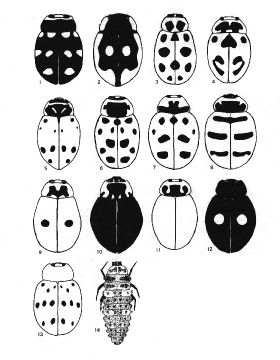
(An electronic reprint of Entomology Notes #6, copyright Michigan Entomological Society)

(An electronic reprint of Entomology Notes #6,
copyright Michigan Entomological Society)
Lady beetles belong to the beetle family Coccinellidae which means "little sphere". There are probably as many as 4,000 species found world-wide and over 350 kinds are found in North America. Most common Northeastern species can be identified by the pattern of spots on their elytra (flight wing covers) (see Figs. 1-13).
Like all beetles, the lady beetles have a complete metamorphosis with distinct egg, larval, pupal, and adult stages. For many species, in the North at least, there appears to be one generation a year. Adults of one common species, the Convergent Lady Beetle (Hippodamia convergens Guerin), spend the winter in protected hiding places such as logs, buiIdings, ground covering vegetation, and the like, where many hundreds of individuals may cluster together. With the onset of spring the adults leave their winter homes and fly to fields and yards where mating takes place. The females deposit the eggs in clusters of up to a dozen per mass. The larvae hatch from the eggs in about a week and immediately start to consume aphids or other appropriate food. In a little less than a month they pupate and the pupal period lasts only about one week. When the adults emerge they too feed on aphids, but as fall approaches they may eat some pollen which supplies fat for winter hibernation.
The appetite of lady beetles is quite remarkable. An adult female Convergent Lady Beetle may consume up to 75 aphids a day while the smaller male may consume up to 40. One larva may eat up to 350 aphids during its life span.
Most lady beetles are predatory but a few species are plant feeders and one of these, the Mexican Bean Beetle (Epilachna varivestis Mulsant), can be a serious pest in bean crops. Predatory ones are sometimes used to control pest species such as the case of a lady beetle species which was introduced into California from Australia in 1888 to combat the cottony cushion scale insect which seriously threatened the California citrus crop. This scale was accidentally imported from Australia and the lady beetle there was one of its natural enemies. When the lady beetle was imported too, it brought the scale under control.
Lady beetles have some interesting means of protection. Their red or orange and black coloration warns birds that they would not make a very tasty meal. Birds learn that insects that are red and black or yellow and black usually sting or taste bad and hence they leave such insects alone. Lady beetles, of course, can't sting, but they probably do taste bad. They also will "play dead" when in danger. Many predators will not eat an insect that doesn't move. Also, lady beetles probably produce a bad smelling odor, perhaps by way of a fluid from joints in the legs, which may help to protect them. The larva of lady beetles is a rather fearsome looking creature. It is somewhat alligator-shaped and covered with bumps and spines (Fig. 14). In most species the larva is a fierce predator which you might guess if you look at its sicle-shaped jaws. Despite the small size of the creature, it can produce a distinctly felt nip on one's finger if handled.
Lady beetles live in a wide variety of habitats. Trees, shrubs, fields, beaches, and even houses are good places to look for them. Since many are very tiny, they escape notice and one good method of finding them is by "sweeping". This involves passing an insect net through grassy areas or low shrubbery with sweeping motions. After several sweeps are taken, examine the contents of the net. In appropriate areas this will frequently turn up many lady beetles.

Since about 1994, the Multicolored Asian Lady Beetle (Harmonia axyridis) has become very notable in the midwest due to its size, variability in markings, and in the sheer numbers seen in the fall months around buildings. This species seems to have adapted to our climate very well, and has become a nuisance around homes when the adults congregate in the fall. The following links will provide additional information on lady beetles and on Harmonia axyridis.